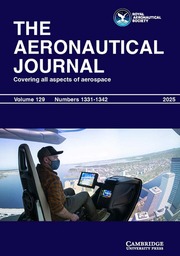No CrossRef data available.
Article contents
A study of the three-dimensionalinteraction of wakes and boundarylayers
Published online by Cambridge University Press: 04 July 2016
Summary
This paper concerns the study of the three-dimensionalinteraction of a slat wake and a wing boundarylayer, as commonly occurs on the suction surface ofa high-lift rnulti-element aerofoil. Theexperimental test case has a realistic slat-wingflow configuration under infinite swept wingconditions. This enables the effect of the crossflow induced by the wing sweep on the slat wake andthe wing boundary layer interaction process to beinvestigated. A triple hot-wire system has been usedto measure the mean velocity and Reynolds stresscomponents in the flow field. The measurements areused to validate a three-dimensional boundary layercode, which has been modified to calculate thisthree-dimensional wake-boundary layer mixingflow.
Information
- Type
- Research Article
- Information
- Copyright
- Copyright © Royal Aeronautical Society 1995

